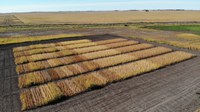NDSU broadleaf crops variety trial data now available
(Click the image below to view a high-resolution image that can be downloaded)
Researchers from the North Dakota Agricultural Experiment Station annually conduct variety evaluations at the Research Extension Centers and cooperating producer’s fields. Through these trials, data about flax, canola, field pea, dry bean, sunflower and soybean yield, and quality traits is generated and published.
The variety selection guides summarize the results of variety trials conducted in 2022. Summary guides for all major crops can be obtained at www.ag.ndsu.edu/varietytrials/variety-trial-results. The PDF guides can be downloaded and printed.
On the same page, variety trial results for major and minor crops can be found by each test location. Printed copies of selection guides also can be obtained from NDSU Research Extension Centers, Extension county offices or from Agriculture Communication at NDSU.
“The selection guide series with variety information about North Dakota’s main broadleaf crops including soybeans, is a very good source for decisions on which variety to grow in 2023, based on unbiased university research” says Hans Kandel, NDSU Extension broadleaf crops agronomist.
“The best way to select a high-yielding variety is to use data averaged across several locations and years,” says Kandel. “Selecting the right variety or hybrid is one of the most important management decisions in the profitable production of field crops.”
With so many varieties to choose from, variety selection can be challenging. The variety selection tool found at https://vt.ag.ndsu.edu/ is designed to assist farmers with finding the most appropriate variety for their farm by accessing, sorting and visualizing variety trial data.
The variety tool is part of the NDSU Ag Hub at https://www.ndsu.edu/agriculture/ag-hub. Farmers can select any of the field crops tested in North Dakota and a specific trial location. Then a sortable table will show the varieties, characteristics measured in the field, yield and quality traits observed. Each column can be sorted, so farmers can find the information needed quickly. Data can be sorted by test location, zip code and radius, or drawing a polygon around the area of the state on the map of North Dakota.
NDSU Agriculture Communication – Dec. 8, 2022
Source: Hans Kandel, 701-231-8135, hans.kandel@ndsu.edu
Editor: Kelli Anderson, 701-231-6136, kelli.c.anderson@ndsu.edu


